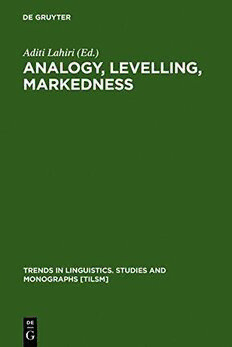
Analogy, Levelling, Markedness: Principles of Change in Phonology and Morphology PDF
Preview Analogy, Levelling, Markedness: Principles of Change in Phonology and Morphology
Analogy, Levelling, Markedness W DE G Trends in Linguistics Studies and Monographs 127 Editor Werner Winter Mouton de Gruyter Berlin · New York Analogy, Levelling, Markedness Principles of Change in Phonology and Morphology edited by Aditi Lahiri Mouton de Gruyter Berlin - New York 2000 Mouton de Gruyter (formerly Mouton, The Hague) is a Division of Walter de Gruyter GmbH & Co. KG, Berlin. © Printed on acid-free paper which falls within the guidelines of the ANSI to ensure permanence and durability. Die Deutsche Bibliothek - CIP-Einheitsaufnahme Analogy, levelling, markedness : principles of change in pho- nology and morphology / ed. by Aditi Lahiri. - Berlin ; New York : Mouton de Gruyter, 2000 (Trends in linguistics : Studies and monographs ; 127) ISBN 3-11-016750-6 © Copyright 2000 by Walter de Gruyter GmbH & Co. KG, 10785 Berlin All rights reserved, including those of translation into foreign languages. No part of this book may be reproduced or transmitted in any form or by any means, electronic or mechan- ical, including photocopy, recording or any information storage and retrieval system, with- out permission in writing from the publisher. Printing & Binding: Hubert & Co, Göttingen. Cover design: Christopher Schneider, Berlin. Printed in Germany. In acknowledgement of his past and continuing achievement and inspiration— To one of the contributors, the others would like to dedicate this book: Paul Kiparsky Contents Introduction l Aditi Lahiri Analogy as optimization: 'exceptions' to Sievers' Law in Gothic 15 Paul Kiparsky Analogical levelling of vowel length in West Germanic 47 B. Elan Dresher Hierarchical restructuring in the creation of verbal morphology in Bengali and Germanic: Evidence from phonology 71 Aditi Lahiri Constraints on schwa apocope in Middle High German 125 Renate Raffelsiefen Morphological re-activation and phonological alternations: Evidence for voiceless restructuring in German 171 Frans Plank Inflectional system and markedness 193 Wolfgang Ullrich Wurzel On the origin and development of the Central Franconian tone contrast 215 Carlos Gussenhoven The origin of Danish st0d 261 Tomas Riad Prosodic variation in 'Lutgart' 301 Paula Fikkert viii Contents The revenge of the uneven trochee: Latin main stress, metrical constituency, stress-related phenomena and OT 333 Haike Jacobs On the (non-)existence of High Vowel Deletion 353 Richard M. Hogg Index of subjects 377 Index of names 382 Index of languages 384 Introduction Aditi Lahiri Although the notion "analogy" has been around for several centuries, different disciplines and different schools of thought have assigned disparate interpretations to the term. The literature on this theme is vast and controversial. The term "markedness" is less used as a scientific notion in disciplines other than linguistics. Nevertheless, the expression is equally open to dispute. Since this book is on analogy and markedness in language change, I will indulge in referring to a few of the usages of these terms with illustrative quotes from the literature in past times.1 In mathematics, the term "analogy" expresses a similarity in relation- ships which are proportional (coming from Greek ana logon, 'according to a ratio'). In Aristotle's usage, the analogy concerning the distances a, b, c, d in (1) can be stated as follows: as a is to b, so is c to d. (i) If distance d is unknown, but its relation to c is known to be similar to that in which known distances a and b stand, then it can be calculated on the basis of the equation of proportions a:b = c:x, χ = b*c/a. Among the numerous references to proportions in the literature, here are a few illustrative ones:2 1557 Recorde Whetst. C ij, If any one proportion be continued in more then 2 nombers, there maie be then a conference also of 2 Aditi Lahiri these proportions..that conference or comparison is named Analogie. 1660 Barrow Euclid v. def. 4 That which is here termed Propor- tion is more rightly called Proportionality or Analogy. 1742 Bailey, Analogy [in the Mathematicks] the Comparison of several Ratio's of Quantities or Numbers one to another. Another form of analogy noted by the Greeks is that of inferring similarity of function, where the relationship is expressed as follows: as a is in b, so c is in d. Plato employed a functional analogy when he argued that the Idea of the Good makes knowledge possible in the intelligible world just as the Sun makes Vision possible in the perceptual world. Here a relationship not yet understood is analogous to one already familiar. Extending this notion, acceptance of the analogy "Knowledge is to the mind, what light is to the eye" makes light, or enlightenment, or illumination, an analogical word for know- ledge. In logic and philosophy the notion of inference is predominant in any use of analogy. The term is used in reference to the process of reasoning from parallel cases and presumptive reasoning based upon the assumption that if things have some similar attributes, their other attributes will be similar. The first Encyclopedia Britannica (1771) stated that "A great part of our philosophy has no other foundation than analogy, the utility of which consists in superseding all necessity of examining minutely every particular body; for it suffices us to know that every thing is governed by general and immutable laws, in order to regulate our conduct with regard to all similar bodies, as we may reasonably believe that they are endowed with the same propertie" (p. 142). Towards understanding whether inferences by analogy can arguably be a form of inductive reasoning, the following three quotes from the OED are instructive: 1774 Goldsm. Nat. Hist. 1.143 Some philosophers have perceived so much analogy to man in the formation of the ocean, that they have not hesitated to assert its being made for him alone. 1843 Mill Logic iii. xx. § 1 The word Analogy as the name of a mode of reasoning is generally taken for some kind of argument
